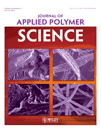Structure and property relations between the polyacrylonitrile-based prestabilized fibers and the partially carbonized fibers
Abstract
The structure of polyacrylonitrile-based prestabilized fibers and partially carbonized fibers prepared in air and nitrogen were studied by Fourier transform infrared (FTIR) spectroscopy and X-ray diffraction (XRD), the thermal properties were measured by differential scanning calorimetry (DSC) and thermogravimetry analysis (TGA), and the mechanical properties and corrosion properties resistant to concentrated sulfuric acid are also tested. Oxygen functional groups form in the fibers prestabilized in air, providing active sites for dehydrogenation and intermolecular crosslinked reactions, which facilitates the formation of turbostratic graphite structure in partially carbonized fibers. The fibers prestabilized in nitrogen and their corresponding partially carbonized fibers are brittle feature, and have comparatively low tensile strength and elongation. The fibers prestabilized in air did not change the color of concentrated sulfuric acid until being etched in it for 6 h; by contrast, the fibers prestabilized in nitrogen were dissolved out only within 1 min. It indicates that the former has better chemical stability than the latter. The present work provides direct evidence that oxygen containing structure in prestabilized fibers is an essential precondition for obtaining high property carbon fibers. © 2011 Wiley Periodicals, Inc. J Appl Polym Sci, 2011




